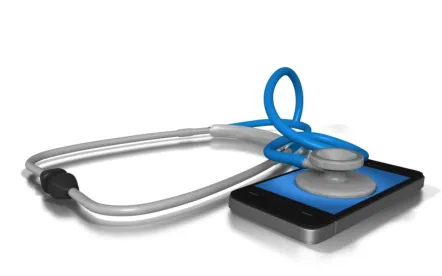The Office of the Inspector General (“OIG”) recently issued Advisory Opinion 22-08 (the “Advisory Opinion”), concluding that the provision of limited use smartphones by a federally qualified health center (“FQHC”) to existing, low-income patients (the “Arrangement”) lacked the intent required to violate the federal Anti-Kickback Statute (“AKS”)[1] and was not likely to generate remuneration prohibited under the federal Civil Monetary Penalties Law prohibiting inducements to health care program beneficiaries (“Beneficiary Inducement CMP”)[2].
The Arrangement
The FQHC served predominantly low-income individuals[3] including Medicare and Medicaid beneficiaries and offered telehealth services to its patients through a telehealth application, which could be downloaded onto a smartphone.
The FQHC received funding from the Federal Communications Commission (“FCC”) and a local charity to provide smartphones and certain data services to its patients.[4] The FCC funding was intended to facilitate the ability of healthcare providers to procure telecommunication services and connected devices for the purpose of making telehealth services available to patients during the ongoing COVID-19 public health emergency (“PHE”).
The FQHC loaned the smartphones on a first-come, first-serve basis to existing patients who did not possess a smartphone capable of running the telehealth application. Patients eligible for the program were required to have received at least one service from the FQHC in the preceding 24 months and reported income levels at 200 percent or below the Department of Health and Human Services federal poverty guidelines. The Arrangement was limited to 3,000 smartphone devices and did not extend to new patients.
In addition to the provision of loaned devices, the FQHC made no-cost voice and data services available to patients for up to 14 months after which patients were required to pay directly for these services. The smartphones were available to be utilized only to make or receive phone calls, send or receive text messages, receive telehealth services via the FQHC’s application, and/or view patient medical records. The smartphones could not be used for downloading applications or browsing the internet, and any patient who no longer received services from the FQHC was required to return the smartphone.
OIG Analysis
The Federal Anti-Kickback Statute
The AKS makes it a criminal offense to knowingly and willfully offer, pay, solicit, or receive anything of value (in cash or in-kind) to induce the referral of an individual for any item or service reimbursable under a federal health care program.[5] Violation of the AKS can result in a maximum fine of $100,000, 10 years imprisonment, or both, per violation.[6]
The OIG found that, while the arrangement did not fall within the safe harbor provisions of the AKS, the safeguards of the Arrangement presented no more than a minimal risk of fraud and abuse under the AKS for the following reasons:
-
Neither the FCC nor the local charity that provided funding to the FQHC had a financial interest in any patients selecting the FQHC for services;
-
The FQHC reported that it had followed all of the funding requirements imposed by the FCC and the local charity; and
-
There was no support to suggest that the smartphones would be utilized by the FQHC to inappropriately increase the utilization of federally reimbursable services despite the FQHC’s intent to continue to permit patients to utilize the smartphones after the PHE expired.
Beneficiary Inducement CMP
The Beneficiary Inducement CMP imposes civil monetary penalties on any person that transfers or offers a free item or service to a Medicare or state health care program beneficiary that the person knows or should know is likely to influence the beneficiary’s selection of a provider, practitioner, or supplier, for the order or receipt of any service which is paid for by Medicare or a state health care program. Notwithstanding, the provision of an item or service that “promotes access to care and poses a low risk of harm to patients and Federal health care programs” is an exception (the “Promotes Access to Care Exception”).[7]
Promote Access to Care
In assessing whether the FQHC’s provision of free smartphones and data promoted access to care under the Arrangement, the OIG concluded that the Arrangement improved the ability of Medicare and Medicaid beneficiaries to access telehealth services during the PHE for the following reasons:
-
Given that the majority of the FQHC’s patients reported incomes at or below 200% of the federal poverty guidelines, the provision of limited-use smartphones may reduce socio-economic barriers to accessing telehealth services;
-
Remote patient monitoring and mobile health applications provided healthcare providers with the ability to deliver quality health care directly to patients, regardless of location; and
-
The Arrangement was limited to patients who did not already have a device capable of operating the application required to access telehealth services from the FQHC.
Risk of Harm
The OIG concluded that the Arrangement posed a low risk of harm by evaluating the likelihood that the renumeration interfered with clinical decision-making, increased costs to federal health care programs or beneficiaries through overutilization or inappropriate utilization, and raised patient safety or quality-of-care concerns. In reaching this conclusion, the OIG highlighted the following features of the Arrangement:
-
The Arrangement was unlikely to interfere with clinical decision-making because there was no information to support that the use of smartphones by patients adversely impacted the clinical decision-making of medical professionals providing services to the FQHC’s patients;
-
The risk for overutilization or inappropriate utilization was low because:
-
The arrangement was limited to existing patients who already had the smartphones;
-
The patients received at least one service from the FQHC within the prior year;
-
The smartphones had limited functionality; and
-
Patients were required to directly pay for voice and data services after the initial provision of services; and
-
-
The Arrangement did not pose patient safety or quality-of-care concerns on the basis that the use of telehealth services during the PHE promoted patient safety by reducing physical contact with providers, staff and other patients and that the FQHC did not provide telehealth services when doing so posed risks to patient safety or quality-of-care.
Finally, it is important to note that the OIG found that, in the event that the program did not meet the Promotes Access to Care exception, it would not impose administrative sanctions under the Beneficiary Inducement CMP after the PHE expired based upon the above-referenced features of the Arrangement.
Practical Takeaways
The Advisory Opinion provides helpful insight to healthcare providers considering arrangements intended to enhance access to telehealth services during the PHE and beyond. Healthcare entities interested in implementing similar programs should be mindful that Advisory Opinions are limited to their facts and binding only with respect to the requesting parties. Experienced regulatory counsel should be consulted for guidance on specific arrangements in advance of implementation.
FOOTNOTES
[1] Section 11128A(a)(7) of the Social Security Act (“SSA”).
[2] Section 1128(a)(5) of the SSA.
[3] 94% of patients of the FQHC were noted to have incomes are at or below 200% of the federal
poverty guidelines.
[4] The FCC provided 85% and the local charity provided 15% of the funding received by the
FQHC to purchase the smartphones.
[5] 42 U.S.C. § 1320a-7b(b).
[6] Id.
[7] Section 1128A(i)(6)(F) of the SSA.



 />i
/>i


